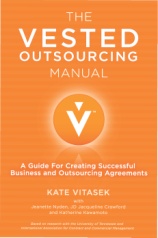Five Tips to Negotiate Your Deal Through Email
Editor’s note: Jeanette Nyden is a frequent contributor to this blog.
We have a love/hate relationship with email. We love instantaneously sharing information with a lot of people. But, we hate getting spammed or deluged with irrelevant “reply all” responses.
We have the same love/hate relationship when using email to negotiate deals. Sometimes we love how efficient email is. But, studies show that we lose more than 50% of our deals when we negotiate exclusively using email. Do you hate that?
Email negotiations are here to stay. We cannot go back in time, but we can improve our skills by immediately applying these five tips.
1) Engage the Reader in a Back-and-Forth Conversation. Negotiation is all about the conversation. It requires a lot of back-and-forth conversations to get to the final deal. At the end of short paragraphs ask a question. Questions will help keep the conversation going.
 For example, one of my clients sent a confusing email. When she corrected the information, she closed with a question. Will this information cause any problems on your end? The other party responded that it would not. If the information had created a problem, my client would have wanted to know. Her question would have elicited that information.
For example, one of my clients sent a confusing email. When she corrected the information, she closed with a question. Will this information cause any problems on your end? The other party responded that it would not. If the information had created a problem, my client would have wanted to know. Her question would have elicited that information.
People are notorious for sending back one sentence responses. I get asked all the time about dealing with one sentence responses. One liner’s could kill your deal. Add a question or two with your response.
2) Carefully Select Subject Lines. Subject lines are the reader’s first impression, so use subject lines wisely. For example, my client wrote “Quote” as the subject line in her email to the vendor. I suggested that she use “Quote for 2011 ABC Part Including Warranty and Service Options”. Not only does this make a great first impression, it conveys important information to the receiver.
Don’t be afraid to change the subject lines to fit the body of your email. If you started with “3 points of consideration” and have only one point left, change the subject line to “Last point for consideration.”
3) Structure Your Email for Impact. Layout your emails to make it easy for the receiver to follow the back and forth negotiation process. Long, rambling emails will confuse the reader. Additionally, most people skim and scan emails. That means they’ll miss important stuff in long emails.
For example, be sure to break topics up into bit sized pieces. Then talk about only one topic per paragraph. You may even want to number your paragraphs. In the example above, if you have “3 points for consideration,” number the paragraphs so you can keep track of the agreements on each point. Numbering your points to match your subject line will help people skim and scan your email more effectively.
 4) Choose Your Words Carefully. Words only make up 7% of our communication. 93% of communication is non-verbal, such as tone of voice and facial expressions. All of that non-verbal communication is missing in an email.
4) Choose Your Words Carefully. Words only make up 7% of our communication. 93% of communication is non-verbal, such as tone of voice and facial expressions. All of that non-verbal communication is missing in an email.
Negotiators take two different paths when using email. Some negotiators choose words to convey an emotional context that non-verbal communication would usually convey. For example, they might use words like surprised, or pleased, or disappointed. Typically, in a phone call or face-to-face meeting, a person’s voice or face would express those emotions.
Other negotiators strip all emotion words out of the email and stick to the facts. In those circumstances, the negotiator would convey emotional context only during in verbal communications. In both situations, you will have to consciously choose your words.
5) Make Effective Tradeoffs. A tradeoff is a mutual exchange of value. Times are tough; margins are tight and everyone wants a great deal. Before you can make a tradeoff though, you have to know what you are willing to offer (pay the price the service provider is asking) and what you need in return (what meaningful service additions) to make it a mutual exchange. If you don’t know, take a minute to think about it.
While it’s more difficult to make tradeoffs in an email, it can be done. One of my clients—a supplier—got an email that one of their parts was defective. Rather than respond with the warranty information, my client asked a question in the email. She asked about how the part was malfunctioning. The customer was installing the part wrong; the part was not defective. The email tradeoff was to send a representative to install the part correctly and train the mechanics at the same time at no charge to the customer. That email satisfied both companies.
Email is here to stay as the preferred business communication tool. The best uses for email are to send data to your counterpart, to summarize conversations and meetings, and to double check assumptions, like timelines. If you and your counterpart prefer to use email to communicate, make sure that it reads like a back and forth conversation you might have if you both were actually talking.
You can also improve your odds of successfully closing a deal using email by making small, significant changes to what you include in your email message. Carefully craft your subject lines. Break long rambling emails into bit sized pieces. And, finally, ask questions. You want to have a conversation, not just a one way data dump.
